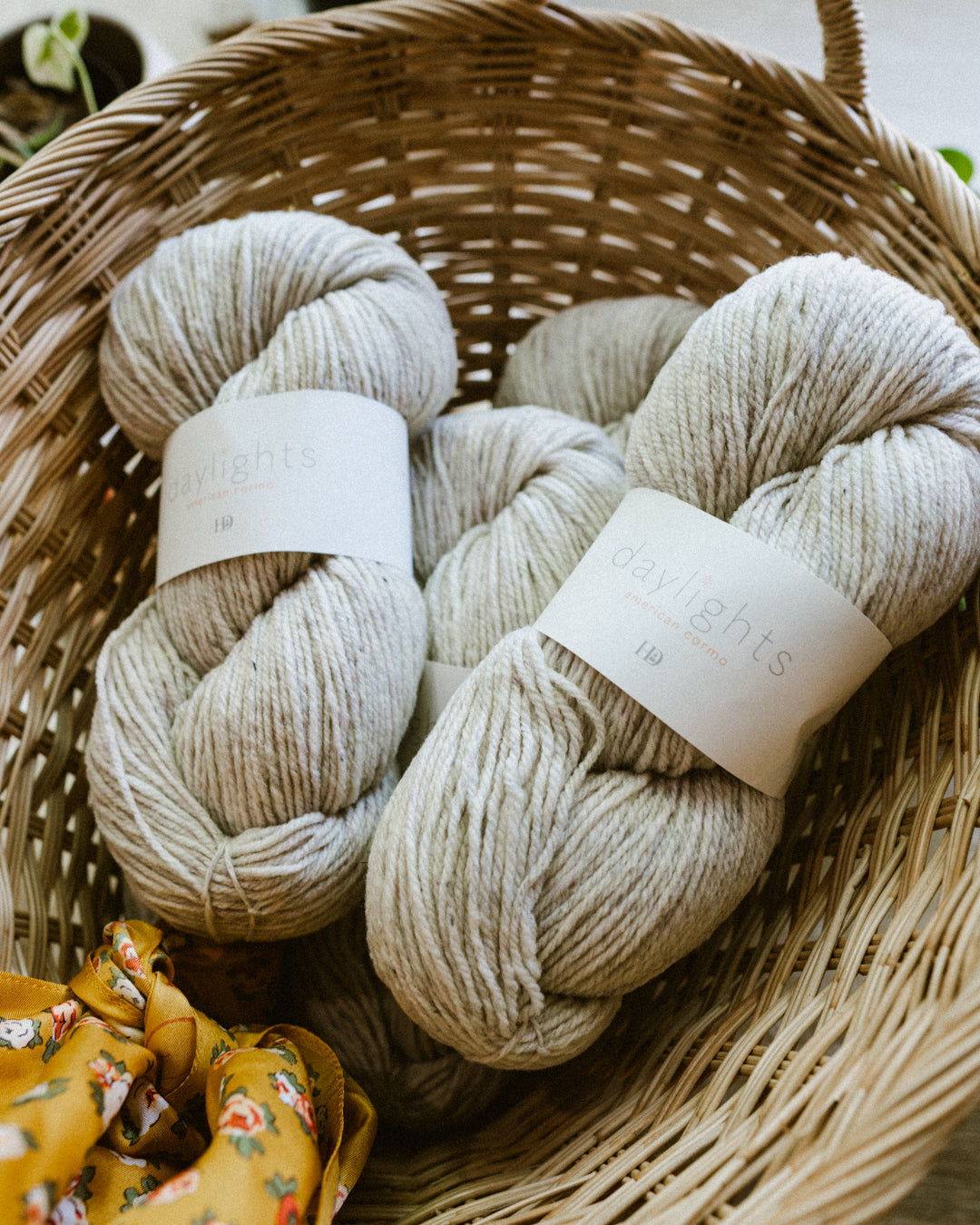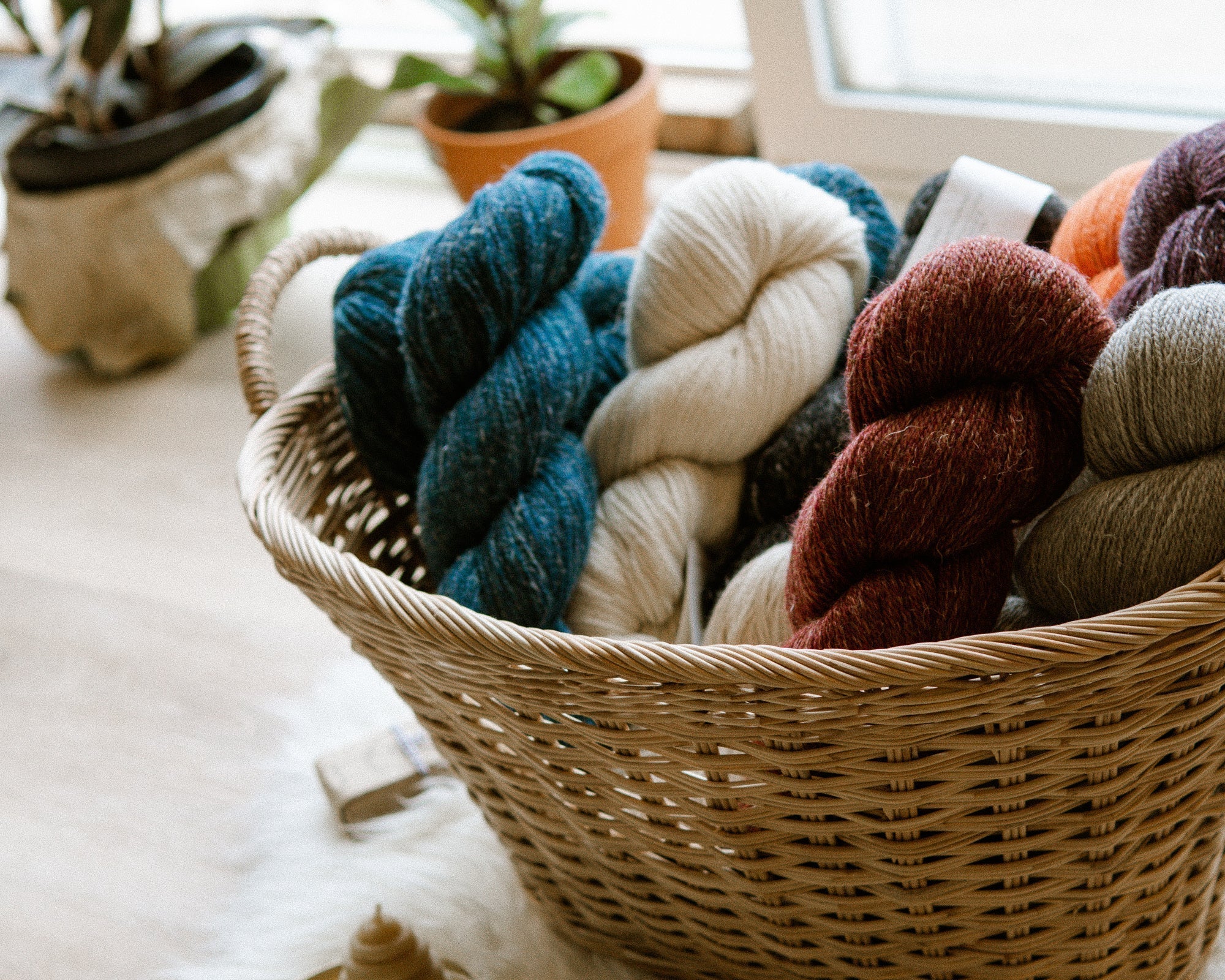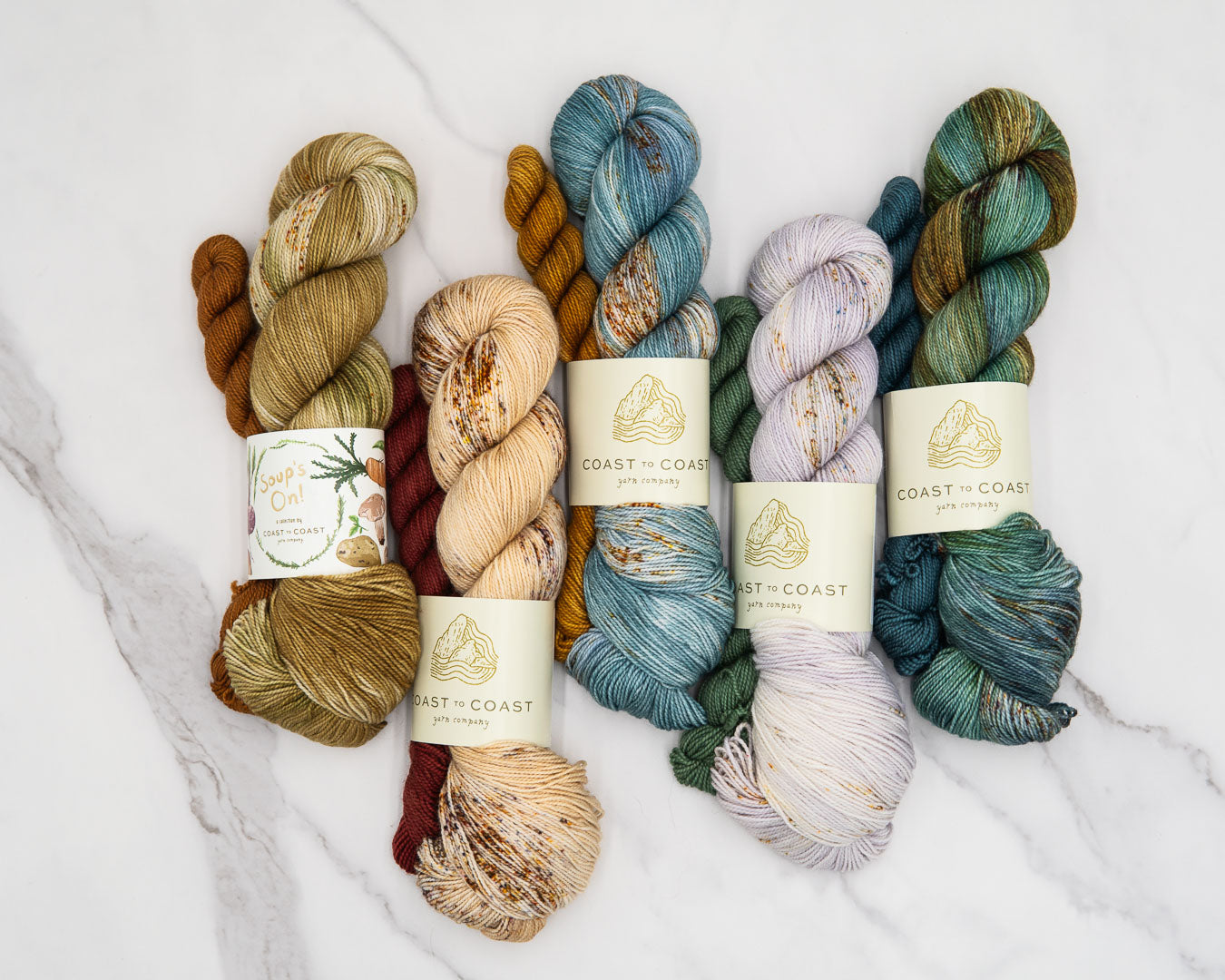
How to choose the best knitting yarns for beginners
As a knitting designer, teacher, and just lover of all things fiber arts (I spin, sew, and weave too!), I often get asked about what I think are the best knitting yarns are for beginners. New knitters might want a definitive answer, but unfortunately, the answer to this is "it depends!"
There are so many different types of yarn on the market and they can get really really confusing, really quickly. There are a huge variety of factors that might impact whether a yarn is a good choice for you or not.
And often times, the "perfect yarn" changes for different projects. So, today let's go through some different types of yarn that I think may be an excellent choice for your first few knitting projects!
Because I'm the way I am, I won't just be asking you to trust me on what I think are the best beginner friendly yarns in a listicle format, especially since I'm an online yarn shop owner with a vested interest. We'll be taking a close look at the different qualities that make up a great beginner yarn.
While I own an online yarn shop, some of the links in this post are affiliate links (clearly marked) for more affordable beginner options!

What yarn weight should I use?
Yarn comes in a loosely enforced (by loosely, I mean not at all) list of standardized categories for how thick they come. According to the Craft Yarn Council, here are the different weight classes, as well as their matching WPI, or wraps per inch.
To determine your wraps of inch, gently, without stretching the yarn, wrap it around a ruler or an WPI tool, and count how many wraps of it fit into an inch neatly, with no overlaps and no gaps.
Yarns generally come with labels denoting their thickness, but often times when I bring one into the shop, I find that it works up in a neighboring weight range instead and label it as such in my shop.
This is a good example of how weight classes can be a little bit subjective. In wool fibers especially, a yarn can change in its character after the wash and the stitch definition changes, and the weight can even change.
According to the Craft Yarn Council, here are the different weight classes, as well as their matching WPI, or wraps per inch. I've put this chart below and linked each weight to their corresponding yarns in my shop (if we carry them):
| CYC weight | WPI |
|---|---|
| 0 Lace | 30-40+ |
| 1 Super Fine | 14-30 |
| 2 Fine | 12-18 |
| 3 Light | 11-15 |
| 4 Medium | 9-12 |
| 5 Bulky | 6-9 |
| 6 Super Bulky | 5-6 |
| 7 Jumbo | 1-4 |
Of these, some of the yarn weights in this numbering system have different names! And they are listed below:
- Super Fine is sometimes called Sock or Fingering, or even Baby.
- Fine is sometimes called Sport, Baby.
- Light is sometimes called DK or light worsted.
- Medium is called Worsted or Aran.
- Bulky is sometimes called Chunky yarn, or Rug yarn.
- Super Bulky is sometimes called roving, and so is Jumbo.
Sometimes, you'll see notation like 2-ply, 4-ply, 6ply yarn to mean lace weight, fingering weight, and DK weight, and so on. This is in reference to how yarn used to be manufactured for each weight as a standard class, and doesn't have anything to do with ply count.
So, if you see labels like this, you will want to read between the lines to try to understand if that's the actual ply count or if it's the weight of yarn, or the thickness!
Now, which is the weight for the best knitting yarns for beginners?
In my experience, it's easiest to start with "light" DK weight yarn, or maybe "medium" worsted weight yarn. The further you go beyond medium size yarn into the bulky weight yarn, even into super-bulky range, the more the actual thickness of the yarn seems to vary. And of course, the thicker the yarn, the faster something knits up, compared to lighter weight yarns.
However, in my opinion, DK or Worsted are a good option, of the thicker classes of yarn, as many wearables stay flexible and lovely at this weight. These yarns are large enough to knit up relatively quickly, and for you to see your individual stitches in easily, but not so big that it weighs a ton and doesn't make a practical finished object.
Wait, what are plies?

Yarn is made of fiber, either made of sheep's wool, manmade-material, and others. The yarn fiber is spun, or twisted, to hold all the fibers together. Sometimes, they are left this way loosely twisted as a single-ply yarn, and sometimes, they are "plied" or twisted together in the reverse direction of the original twist, to create a 2 or more ply yarn.
You can see in the photo above what it looks like when I am twisting some wool fiber into a single ply before it is plied for the final two ply yarn. The twist enters the fiber to make it into yarn between my fingers, and the fluff below where my fingers start is still fluff!

Shown above is a yarn with two plies, that I hand spun on my wheel. You can see in this photo that in some spots, the two plies have different colors and wrap around each other to make that yarn. In yarns dyed in the wool like this before being spun, you can really see the clarity of those plies!
For knitting yarns for beginners, you'll want one with at least two plies. The number of plies in your choice of yarn actually does matter. A single ply will fall apart when you try to take it apart if you make a mistake, and has less structural integrity generally.
Sometimes, a retailer won't clearly label plies that are 2 or more on their website, but it'll sometimes show up in the yarn label. And sometimes not!
This can get really confusing, and if you already have some yarn on hand, and you are curious, there is a way. You can gently pull apart the end of the yarn to count how many plies there are that makes up the overall structure of the thicker yarn.
As long as there's 2 or more plies, I think you're gonna do just fine. However, I would avoid patterns that hold multiple strands of yarns together for your first project---for now, stick with a single strand, please!
On our website, in the product descriptions, every yarn will be clearly labeled. You can easily see the weight, the yardage, the ply count, the method of spinning and processing, and the "put up." But wait, what is a yarn "put up"?
What kind of yarn "put up" should I use?
A put up is just a description of how the yarn is wound for storage. Yarn comes wound in a variety of ways, each with their own advantage or disadvantage. I go over yarn put ups like skeins, balls, hanks, and more in a separate post. For beginners I recommend something like a skein (NOT a twisted hank, which many retailers label their products as), or a ball, as they need no further preparation to be worked immediately.
Winding twisted hanks, which look like attractive little braids from hand dyers, is an art in itself. Because of that, the best thing to do is for beginners to save that for a little later.
For now, knitting yarns for beginners are most easy to work with when they come in a ball or a skein.

Shown is Penelope, a DK weight yarn in our shop wound in a "ball" format.
Both retail balls balls of yarn and skeins of yarn can have their troubles (namely, that the closer you get into the middle of them, the more they're likely to tangle), but they're still a lot easier to work with IMO. Here are some examples of balled and skeined yarns:
- Penelope, Wool and Silk, DK weight yarn, $12 / 50 g (in our shop) - This is a luxury choice, but I've put it here because it uses superfine merino wool and is soft to the touch. This smooth yarn is "next to skin" friendly and absolutely a bouncy, easy joy to work with.
- Wool of the Andes, Peruvian Highland, Worsted Weight yarn, $2.99 / 50g (Knitpicks, Affiliate Link) - Wool of the Andes comes in skein form, wrapped in a bullet shape so that you can work straight from the outside of it. This is a great choice for a first wool yarn. Peruvian Highland is a relative of Merino and behaves similarly, but can sometimes have a higher micron count and is a little less smooth to the touch.
But what if I really want to use hand dyed yarn and it comes in a twisted hank?
My first knitting project EVER involved some really luxurious, kettle dyed merino yarn from Malabrigo. I had truly no fear, and wound it off the back of a chair, and it was terrible. Just an absolute mess.
I didn't know that there are tools that make this a lot easier, and if you are not a careful person like me, you might want to consider looking into these tools, or asking a local yarn shop or a friend for help in winding hanks.

Now, if you are like me, and you really want novelty yarns, or yarns that are hand dyed in a beautiful variety of colors like the above pic, and you would like to purchase twisted hanks, I highly recommend that you be prepared with a yarn swift (KnitPicks, affiliate link) to wind your yarn into balls with. I did not have a good time winding a hank without one, so please learn from my mistakes!
Alternatively, ask for help on this and most of us yarn lovers would be so happy to help.
The right tools are so important, and I think finding yarn that really gives you joy is really important too. Having beautiful yarn to work with can be such a mood boost.
What if I can't use traditional wool?
If you're just starting out, should you be choosing synthetic fibers or natural fibers? Fiber type is is probably one of the most important factors in choosing the best knitting yarn to learn with.
Personally, I'm a huge fan of wool yarn, and I think a fine, low-micron count merino wool is suitable for almost everybody. I would avoid a woolen spun yarn, because they are more chaotic and stick out more, if you are looking to try any wool at all. Our yarns are clearly labeled with "Worsted spun" and "woolen spun" to signify which is which. (By the way, Worsted spun is NOT the same thing as worsted weight.. I know. It's the worst.)

Shown is a stack of knits using a woolen spun alpaca and wool blend yarn as well as an unspun yarn. Notice how rustic and prickly the texture looks.
Some folks have sensory issues with the ends of the wool fiber, finding it itchy. Furthermore, some folks have a true wool allergy that also extends to other animal fibers like alpaca, cashmere, and llamas.
Additionally, it's really hard to find "softer" wool yarn at big box stores like Michael's or JoAnn's. So I actually think it's a good idea look for smaller yarn stores in your area, and try to feel the acrylic and wool yarns there.
If you do not tolerate 100% wool, you may tolerate a wool blend, or superwashed merino. Superwash is a process where the fibers have been chemically treated to be smooth which often gives it a "soft" to the hand touch to those sensitive to wool texture.
I recommend wool yarns that are non-superwashed if you can tolerate it, and superwashed wool or acrylic if you cannot tolerate natural wool. Wool and acrylic yarn are very resilient and "Sticky" fibers. Their fiber content means they don't fall off the knitting needles so easily.
And the most important thing is, these fibers have stretch to them, but won't be falling off. So in your learning process you won't be gripping those needles to death as often, and can focus on the other techniques.
For this reason, I do not recommend cotton yarn or silk yarn, which has little stretch and can be very uncomfortable to knit even for seasoned knitters. I do carry them in shop. They can be "splitty" as well, where your needles goes into your yarn for your knit stitches but it splits the two plies and only picks up half the yarn. This is an annoying thing and best saved for more seasoned knitters.
If you don't have access to a local craft store for your first project, you can find inexpensive wool, superwash wool, and acrylic yarns online so that you can try a little of all three. I highly recommend purchasing just one unit of each, trying it out, before committing to a larger quantity of each.
Here are a few really affordable options for knitting yarns for beginners, from KnitPicks. They are easy to work with, and easy on the budget:
- Brava Worsted, an Acrylic, Worsted Weight Yarn, $3.99 / 100g (KnitPicks, Affiliate Link) - This is my choice for people with a full on wool allergy who does not want to try any wool fibers whatsoever.
What patterns do I use these yarns with?
Last thing for you... without a good pattern, no amount of great yarn will help you learn to knit. Entire books could be written on this, but I myself learned on TinCanKnits' Simple Collection, a group of free patterns for absolute beginners. I learned from these myself, but you can also take a class at your local yarn store.
I'm a designer for more advanced patterns than these, so I heartily recommend them. When you are ready for some more techniques and beautifully fitted garments, we have a Shop By Difficulty page for advanced beginners and up.
Additionally, I explain more intermediate to advanced concepts on this blog often, and you can find a directory of all of my knitting resources by topic.
We hope that you have enjoyed this article and find it helpful. We carry a number of truly delightful yarns in our shop and hope you get a chance to check them out!




Leave a comment
This site is protected by hCaptcha and the hCaptcha Privacy Policy and Terms of Service apply.